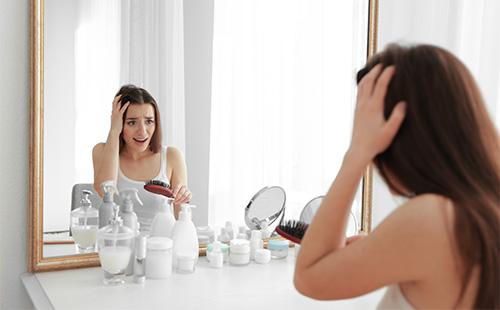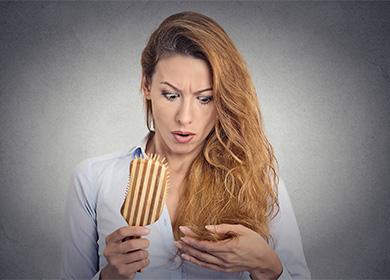The content of the article
According to statistics, approximately 40% of the population, whose age has not reached 50 years, suffers from hair loss. And if 15-20 years ago, alopecia was the inheritance of only the male half, today thinning of hair is more and more often observed in women. What methods can be used to deal with diffuse baldness, and why is it necessary to immediately contact a trichologist?
Hair thinning, and even more so alopecia of a non-hormonal etiology or focal diffuse alopecia for any female person at any age, is a real nightmare, because at first it is completely incomprehensible - what it all means, what causes it, how to stop it and how to treat it. A forum can provide psychological support, there you can also get some useful tips, but a specialist should definitely be involved in diagnostics, and not from a photo on the Internet - you must definitely make an appointment.
Diffuse hair loss in women: causes, varieties, symptoms
Diffuse alopecia (or baldness) is the process of uniform thinning of the hair over the entire surface of the head. In this case, the death of hair follicles does not occur. They simply go into hibernation, suspend functioning. This problem occurs with the same frequency in both women and men. Sometimes diffuse baldness is observed even in children.
It is necessary to distinguish androgenic alopecia from diffuse. Forms vary in two clinical and morphological characters.
- Lesion area. Androgenic alopecia provokes loss of strands in certain areas (parting, whiskey). Diffuse - affects the entire surface of the head.
- Cause of the problem. Androgenic alopecia provokes an excess of androgens in the body. A diffuse belong to autoimmune pathologies.
Factors provoking the formation of bald spots
Diffuse baldness is a response to disturbances in the functioning of the body. That is why such alopecia is sometimes called symptomatic. The causes of diffuse hair loss are quite diverse. Among them, five factors are most often encountered.
- Infectious diseases. Severe ailments, which are accompanied by prolonged fever, can trigger the process of baldness. Hair loss begins two months after the infection. Diffuse alopecia are ways to provoke brucellosis, syphilis, flu, typhoid, pneumonia, tuberculosis, mononucleosis and malaria.
- Deficiency of useful components. Compliance with strict diets, poor diet lead to a deficiency of essential minerals, vitamins. Hair is thinning, split, start to fall out. Especially detrimental to the condition of strands are protein-free diets.A lack of protein instantly affects the health of the hair, limits their growth, and provokes hair loss. If diffuse alopecia is diagnosed in women, treatment begins with nutrition correction, intake of vitamin-mineral complexes.
- Taking medication. The use of certain medications is accompanied by such a side effect as hair loss. Medicines that can start the process of baldness include antiparkinsonian drugs, anticonvulsants, anticoagulants, cytostatics.
- Chronic ailments. Hair loss can trigger endocrine disorders, most often - thyroid disease. Diffuse baldness can be based on hypothyroidism, hyperthyroidism. Sometimes lupus erythematosus, erythroderma leads to massive baldness psoriasis.
- Psycho-emotional disorders. Severe shock, stress, depression can cause baldness. Sometimes hair loss, as shown by reviews, may occur after anesthesia or surgery.
The main forms of the disease
To understand how baldness occurs, what are forms of alopecia, you need to go a little deeper into the anatomy. Trichologists claim that all hair goes through three stages of development.
- Anagen. This is the phase at which rapid hair growth and development is noted. Active follicular division is observed. The hair shaft is laid. Synthesized melanin, responsible for the shade of hair. On average, this phase lasts for five to seven years.
- Catagen. An intermediate phase that lasts several weeks. At this time, the follicle cells stop dividing, the synthesis of melanin is inhibited. Hair is preparing for natural loss, moves to the upper layer of the skin.
- Telogen. This phase is sometimes called the resting stage. It provides the loss of "old" hair, is responsible for the rest of the follicles. In place of the obsolete rod, which is easily separated during combing, a new one appears.
Given these stages of hair development, trichologists distinguish two forms of diffuse alopecia. Previously, doctors attributed to this pathology and androgenetic alopecia. But after the last revision of the international classification, we settled on only two forms indicated in the table below.
Table - Forms of baldness, their characteristics and development mechanisms
| Forms | Characteristic | Development mechanism | The reasons |
|---|---|---|---|
| Diffuse telogen alopecia | - Hair falls out a month or two after exposure to a provocative factor; - patients note profuse hair loss; - proceeds in the acute stage and chronic; - complete baldness does not occur; - The acute stage lasts about six months, recedes after proper therapy; - chronic baldness changes with periods of severe loss, exacerbations are observed approximately 2 times a year | - Anagen phase ends ahead of schedule; - Anagen ends late (this is typical for pregnant women, their catagen phase occurs only after childbirth); - the anagen stage is shortened, the strands do not grow to their length; - the telogen stage decreases sharply, anagen occurs without sufficient rest; - the resting stage is extended, telogen ends late | - Psycho-emotional stress; - pregnancy, childbirth; - deficiency of vitamins, minerals; - consequences of operations; - chronic ailments; - disorders in the thyroid gland; - long-term drug treatment; - extreme diets |
| Diffuse anagen alopecia | - Hair falls out quickly; - a woman notices hair loss in whole strands; - sometimes complete baldness occurs; - bulbs remain healthy; - With proper treatment, complete recovery often occurs; - overgrown strands differ in color and structure from previous hair | Under the influence of strong aggressive factors, precipitation is observed in the anagen stage, bypassing the resting phase | - chemotherapy; - radioactive radiation; - poisoning with toxic substances; - radiation therapy |
Signs of pathology
It is not difficult to notice excessive loss of strands. It is enough to carefully look at the comb or pay attention to the amount of hair that clogs the drain after washing your hair. If the number of lost hair rods exceeds the norm (150 pieces per day), it's time to sound the alarm. In addition, four signs characteristic of diffuse alopecia should be noted.
- Follicular weakness. If you take a bunch of hair and gently pull, without applying force, then about ten hair will remain in your hand. Such a loss will not cause you any discomfort or pain.
- Lack of growth. At the place of the fallen hair, the new rods do not grow back, because they have not yet had time to form. Such areas look significantly thinned.
- Appearance deterioration. Hair is thinning, becoming brittle. They lose their natural strength and luster. Oily dandruff often appears. Sometimes the strands become excessively dry.
- Body hair loss. Sometimes diffuse alopecia is noted not only on the head, but also covers the body. Hair may fall on the arms and legs. Sometimes eyelashes or eyebrows get enough sleep. But such symptoms are optional. They may be absent.
Diagnostic Methods
A comprehensive approach is required to determine diffuse alopecia. The purpose of diagnosis is not only to make the correct diagnosis, but also to determine the cause of massive baldness. Therefore, the list of activities may vary in each case. If you suspect diffuse alopecia, the trichologist prescribes one of four diagnostic methods (or several at once).
- Trichoscopy. A modern method of visual diagnosis. Using a special camera, the doctor can examine the condition of the scalp and hair. Trichoscopy reveals thinning zones, determines the ratio of damaged rods to healthy ones.
- Spectral analysis. This is a diagnostic measure that determines the content of minerals and trace elements in the human body. The analysis reveals a deficiency of such important components as iron, magnesium, selenium, zinc, calcium. In addition, it is possible to establish the presence of heavy metals that can provoke hair loss, significantly worsen the condition of the whole organism.
- Phototrichogram. The procedure determines the ratio of hair that are in different phases of growth. Thus, it reveals the intensity of renewal and the activity of the loss of strands. This diagnostic method evaluates the condition of the hair shaft and skin. The event is considered the most effective way to detect diffuse alopecia.
- Lab tests. The patient is definitely recommended to take blood biochemistry, a general analysis, blood for hormones. These studies help determine the causes of baldness.

Treatment methods
The trichologist determines the treatment regimen for diffuse alopecia only after all diagnostic procedures have been completed. Proper therapy performs several tasks at once. It allows you to stop the massive loss, restores the proper functioning of the follicles, struggles with the causes of pathology. That is why the practice of self-treatment is strictly prohibited.
Therapy includes several directions:
- drug treatment;
- physiotherapy;
- the use of folk methods.
If all activities do not bring the desired result, then the patient may be recommended surgical intervention.
Medications
Diffuse baldness is considered one of the mildest forms of alopecia. With the right treatment, this pathology is easy to stop. In most cases, it is possible to completely return the strands to their original appearance. Drugs indicated in the table below may be prescribed with medication.
Table - Drugs and their effects on the body
| Drug group | The name of the drug | Impact | Features |
|---|---|---|---|
| Growth stimulants | - "Minoxidil"; - “Alerana”; - "Cosilon"; - "Generolon"; - “Cromacaline” | - Strengthens blood circulation; - stimulates cell division in the follicles; - activates the growth of new hair | - The results become noticeable after 4-6 months; - requires regular use; - after discontinuation of the drug, the loss of strands sometimes increases again |
| Biostimulant | Esvitsin | - Saturates the scalp with minerals; - stimulates the growth of strands; - awakens sleeping bulbs; - improves the appearance of curls | - It can be applied externally or internally; - results become noticeable after 3 months of regular use |
| Firming drug | Rinfoltil (ampoules, tablets, shampoo, lotion) | - Provides a restorative effect; - regulates the level of androgens; - enriches with zinc, iron, selenium, copper and vitamins; - restores the hair shaft; - improves the condition of the bulbs | - The drug is made on the basis of plant materials; - for better exposure, it is recommended to combine taking tablets with shampoo or ampoules; - the result becomes noticeable after 3-4 months |
| Homeopathy | "Selenzin" | - Activates blood circulation; - normalizes the exchange; - calms the nervous system; - relieves itching and dandruff; - returns natural shine; - thickens the hair shaft; - awakens sleeping bulbs | - The appointment of 8 granules 4-5 times a day; - the treatment is quite long and expensive |
| Drop ointment | - "Maram"; - "Mival"; - “Karmazin”; - “Kapus Professional”; - Dermoveit | - Reduces loss of strands; - enhances growth; - restores the structure, thickness of the hair; - relieves dandruff | Some ointments are hormonal drugs, so they can only be prescribed by a doctor |
| Iron preparations | - “Feroplex”; - “Tardiferon”; - “Ferlatum”; - "Biofer" | - Saturates the body with the necessary substances; - improves hair condition; - relieves of anemia | To improve absorption, ascorbic or folic acid, vitamins B6, B2 are additionally prescribed |
| Sedatives, antidepressants | - chemotherapy; - radioactive radiation; - poisoning with toxic substances; - radiation therapy | - Calms the nervous system; - reduces the severity of depression; - eliminates irritability | - Antidepressants are prescribed only by a doctor; - medicines are used exclusively according to the prescribed scheme |
| Vitamin and Mineral Complexes | - "Pantovigar"; - "Revalid"; - Nutricap | - Saturate with vitamins, minerals; - restore hair; - favorably affect the whole body | Vitamins for diffuse alopecia are selected depending on the cause of baldness (with dermatitis Nutricap is useful, and in case of stress - Pantovigar) |
Physiotherapeutic procedures
To strengthen drug treatment, it is recommended to resort to physiotherapy. The choice of measures depends on the degree of baldness, the age of the patient and the diagnosed diseases. Most often, doctors recommend one of seven treatments.
- Microcurrent therapy. The procedure is performed using low-frequency pulses. It contributes to the expansion of blood vessels, activates metabolism, enriches tissues with oxygen.Such therapy allows you to restore the structure of the hair, get rid of dandruff, normalize the functioning of the sebaceous glands.
- Cryotherapy. Using liquid nitrogen, cold is applied to the scalp. The event improves blood circulation, enhances exfoliation of the dead layer, and eliminates itching and dandruff.
- Darsonvalization. The procedure is carried out using a special comb. Such an event is recommended for those patients in whom hormonal disruptions are detected in the body. Darsonval restores the sebaceous glands, normalizes metabolic processes.
- Plasma therapy. Plasma rich in platelets is isolated from venous blood taken from a patient. It is introduced into the scalp. This allows you to activate the growth of strands, awaken dormant bulbs, restore natural biochemical processes.
- Ozone therapy. An event can be performed in several ways. Highly active oxygen is administered using a dropper, by injection, or the hair is treated with special compounds. Ozone therapy saturates the follicles with oxygen, cleanses toxins, eliminates irritation, reduces inflammation and activates hair growth.
- Paraffin Wrap. Using heated paraffin pre-wrapped in polyethylene, special applications are made on the scalp. The event enhances blood circulation, provides an influx of nutrients to the follicles, helps open pores.
- Laser therapy. The procedure restores the physiological processes that occur in the follicles. The laser provides natural cell division, activates the growth of strands, stimulates biochemical reactions.
Folk remedies
With diffuse baldness, folk remedies are in demand. Doctors even argue that if during the diagnosis no serious disorders were detected in the body (for example, alopecia occurred after childbirth or as a result of surgical intervention), then you can do without medication, one of four healer prescriptions.
- Salt treatment. It is advisable to use sea salt. If it is not, then you can use the usual cookbook. Take a handful of salt, gently rub into the scalp. After 15 minutes, rinse with warm water. Repeat once a week. After a month, you will notice an improvement.
- Burdock broth with calendula. To prepare the broth, it is necessary to stock up with crushed burdock root (20 g) and calendula inflorescences (10 g). Dip the raw materials in a liter of water, boil for five to ten minutes. Allow the broth to cool on its own. Strain it. Rub the resulting medicine into the skin, easily massaging the problem areas. Repeat the procedure every three days.
- Nettle infusion. Gather fresh nettle leaves. Chop them. Pour boiling water. Insist the remedy for six hours. To enhance the therapeutic effect, plantain leaves, chamomile flowers, and sage can be added to nettle. Before use, the infusion is filtered. Herbal remedy is used to rinse hair.
- Kefir mustard mask. Take 250 ml of kefir (2.5%), mix it with one egg yolk, a tablespoon of mustard powder. Mix the components thoroughly. Apply the resulting mask to unwashed hair. Wrap your head. Hold the mask for 15 to 25 minutes, controlling your sensations. If the mask burns too much, wash it off ahead of time. After the procedure, soothe the scalp with a nourishing balm.

Surgical intervention
Hair transplantation - or transplantation - is the most radical method of dealing with diffuse alopecia. However, it is not a treatment method.It is rather a way to hide baldness, which is rapidly progressing, is not amenable to either medication, physiotherapy, or alternative treatment.
Even factors such as smoking, the use of poor-quality hair cosmetics, improper care, and alcohol abuse can provoke diffuse baldness in women. Therefore, noticing the first signs of developing alopecia, immediately change your lifestyle, do not delay the visit to the doctor.
Reviews
I’ve been suffering a problem for a year now. There used to be gorgeous hair, but now it’s runny steel. How many tears shed, which just did not try. Recently, substantially less have been falling. Means such as burdock oil, kefir, eggs, onions and other things will not help with a serious problem, only spend time and effort on them, and there’s no sense in it! Like a dead poultice! When I was seriously afraid that I could lose my hair, I went to the hospital. I donated blood from a vein to biochemistry (liver), to hormones and a general analysis from a finger. The first 2 turned out to be normal, but the general one showed that I have anemia (low hemoglobin). In short, I began to drink iron-containing drugs, eat a hematogen and generally eat better. I bought an expensive drug PANTOVIGAR, you need to drink 6 months. Literally 2 weeks ago I noticed an improvement, I already want to fly with joy!
Mari LaFleur, http://www.woman.ru/beauty/hair/thread/3925682/
When trying to diffuse, I tried strengthening and stimulating masks, to be honest, to no avail. The doctor said that I’m doing stupid things. I would have come earlier to the reception, now I would go with magnificent hair, and so I'm still trying to restore what has been pouring for almost six months.
Mani4ka, http://volosy-forum.com/maski-i-diffuznaya-alopetsiya/498/
I did 7 times in the salon mesotherapy for hair. Yes, it’s sick, but you can tolerate for the sake of beauty. hair has become much larger. communicated with those girls who do this procedure periodically. Praise very much. Therefore, if hair loss is not associated with the disease, then you can stimulate the growth of sleeping hair
Lana http://www.woman.ru/beauty/hair/thread/4273790/

